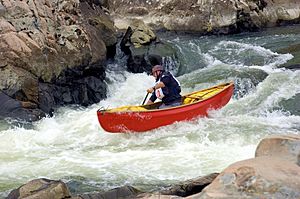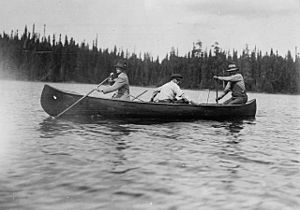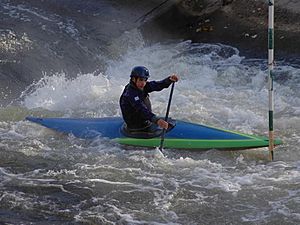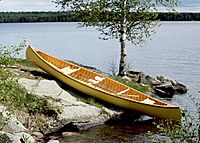Canadian (canoe) facts for kids
A Canadian canoe is a special type of canoe. It got its name because it's like the canoes first used by Native Americans in North America. These canoes were made from birch bark and were perfect for traveling through forests and rivers.
In some parts of Europe, like the United Kingdom, people sometimes think a kayak is a type of canoe. This can be confusing! To make it clear, they often call the open canoes we usually think of as "canoes" a 'Canadian canoe' or just 'Canadian'. For example, in German it's Canadier, and in Swedish it's Kanadensare.
This naming difference caused some mix-ups. For a long time, women were not allowed to compete in canoeing at the Olympic Games. One reason given was that kayaks were already considered canoes, and women could compete in kayaks. Luckily, this changed, and women can now compete in canoe events at the Olympics since 2020.
The Story of the Canadian Canoe
The name 'Canadian' for these canoes came about in the 1800s. Back then, people were just starting to enjoy canoeing as a sport. An open touring canoe from Canada became known as the 'Canadian canoe'. This was because the American Canoe Association (ACA) liked this style.
At the time, there was another popular canoe from Maine in the United States. This one was made of wood and canvas. However, the ACA didn't officially recognize it until much later, in 1934.
Early Canoeing Clubs
In the late 1800s, many canoeing clubs were made up of wealthy people. They believed a proper touring canoe should have a deck and be able to be sailed. They also thought it should be paddled with a double-bladed paddle.
Because of this, they mostly approved of the cedar-rib 'Canadian style' canoe. They didn't think much of the original birch bark canoes. They also looked down on the wood-and-canvas canoes. They called them "rag canoes" and said they were only for workers or "primitive natives."
However, the wood-and-canvas canoes were easier to make and fix. This made them cheaper and much more popular with everyday people.
The Name Spreads
In America, the word 'Canadian' was soon dropped from the name of these canoes. They just became known as "canoes." But in many European countries, people didn't know about these differences. They kept calling all sorts of canoes 'Canadians'. This even included the decked whitewater canoes and, ironically, the wood-and-canvas canoes!
See also
 In Spanish: Canoa (deporte) para niños
In Spanish: Canoa (deporte) para niños









